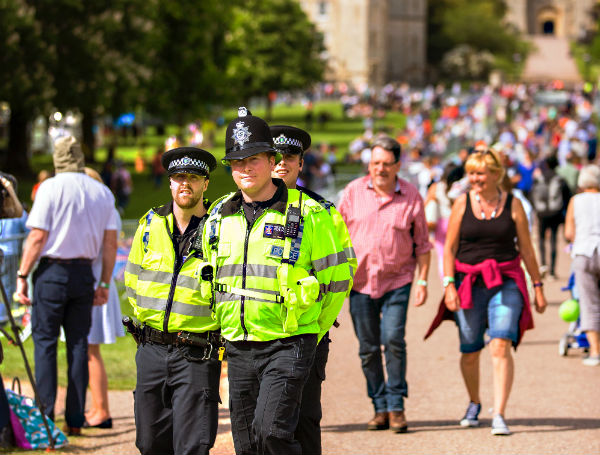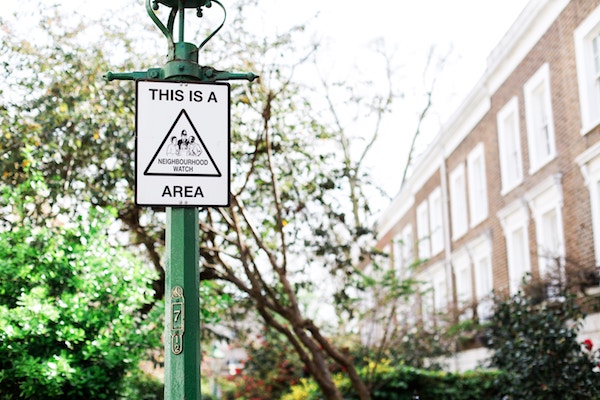
In a society where we refer to our homes as our castles, it makes sense that we also want to feel safe and secure in our residences. But as we spend more time inside looking at screens and less time outside making connections with neighbors, it also makes sense that many homeowners today feel less safe and secure than they did a few decades ago.
The irony is that violent crime rates have decreased even as our feelings of danger lurking around every corner have increased. So what can you do to help assuage your fears -- and actually make your community safer in the bargain?
Plenty! Establishing yourself as a community and working together with your neighbors is one of the best ways to increase feelings of safety while actually reducing crime in your area. Here's how to get started.
Form a Facebook group
Let's face it: We are all on Facebook a lot more than is probably healthy for us. But this can be turned to your advantage if you leverage it as an asset.
Form a community safety Facebook group that is geared toward your specific community. There is more than likely already a general community Facebook group; join that one, too, and ask the moderators if it's okay to advertise your safety-focused group there.
It's up to you if you want to create standards for joining the group. If you decide to do that, it might make sense to recruit a moderator or three to help you manage join requests and to maintain the standards of the group.
You can use this Facebook group to talk about safety issues, advertise safety meetings, make safety-related announcements, and much more.
Leverage Nextdoor
The great thing about Nextdoor -- the neighborhood-focused social network -- is that Nextdoor does the hard work of verifying that the people in your neighborhood group actually do live in your neighborhood (no lurkers!).
Using Nextdoor can be another excellent way to figure out which of your neighbors are interested in helping you increase community safety, and to warn your neighbors of any thefts or other safety risks in the area. If you do use Nextdoor as a warning method, make sure you're providing only factual information and not conjecture or speculation. You want your neighbors to pay attention and act accordingly, not for the conversation to devolve into an argument over whose houseguest might have been trespassing on whose property, or whose kids are inviting unsavory characters into the neighborhood.
To that end, talk to your neighbors online about standards for identifying scofflaws and their behavior (especially underage ones). For example, if there's a teenager who drives erratically and over the speed limit down a road with small children every day, most parents are going to be fine with identifying the vehicle make, model, and color, the sex and general appearance (clothing, hair color, and so on) of the driver, the time of day they usually drive down the road, and other details specific to this situation. Sharing a license plate number or taking a picture of the driver on social media, however, might be considered a violation of privacy by some parents.
Create clean-up groups
Some safety issues emerge because city and county departments might be strapped for cash or short several employees, and things that ought to get done as a result just ... aren't. Maybe a tree fell across a popular trail and hasn't yet been cleared, or maybe there are local public-access staircases that are covered with slippery leaves or other debris.
If there's a safety issue that you can easily and professionally tackle with a group of people, organize one! Use your social media groups or fliers in the local cafe or post office to advertise a clean-up day at the local park or along a busy street. Ask the local dump or trash company if they'd be willing to donate a dumpster or supplies and trash pickup. Sometimes all it takes to make an area safer for everyone is a little coordination and elbow-grease, and the coordination is the hardest part, so try to tackle it and see where it gets you.

Start a neighborhood watch
Do you know all your neighbors? Are you familiar with the cars they drive, their regular visitors, and any special guests who pop in from time to time?
For most people, the answer is "definitely not." But having a sense of who's who in your neighborhood can help prevent a lot of crime, from illegally dumping trash to burglary or robbery.
If your block or neighborhood doesn't already have a neighborhood watch program, consider starting one. The first step is to find neighbors who are interested in participating. Once you have a group of people willing to put in the time, call up your local law enforcement bureau and tell them what you're doing. Many local law enforcement offices will be willing to send a police officer or two to your neighborhood watch meetings, which can be an invaluable resource for helping you learn how to spot and safely report any suspicious activity.
Coordinate meeting times for your neighborhood watch, which can be held in a community space or even online. Talk about the safety issues that concern you the most, and ask your law enforcement liaisons what you can do to help.
Secure your own space
There's only so much that neighbors can do to help you keep your home safe. Ultimately, the responsibility to secure your property lies with you -- so make sure you spend some time looking at your own home's vulnerabilities and decide how to fix them.
For example, routinely leaving your door unlocked when you leave the house is a good way to invite burglary. Some smart locks allow you to remotely lock your door if you forget, so it might be a good idea to upgrade your door lock. New camera technologies allow you to see who's on your front porch when the doorbell
You can't be responsible for everyone's house on the block, but if you're responsible for your own, the odds that you'll experience a safety violation go down. It's worth it!
Problem-solve using SARA (scan, analyze, respond, assess)
Many police departments use the SARA method to solve problems, and it's a method that community safety advocates can also use with a lot of success.
The SARA method involves four steps: scan, analyze, respond, assess. First, scan the situation. Take it all in. Try to absorb everything you possibly can about what's happening. In this step, you are identifying and describing the problem.
Next, analyze the situation. Think about who is involved, what they are doing, what social and economic realities exist that feed into the situation, and try to determine what has caused this situation or problem.
Then, respond to the problem. The response usually works best in a collaborative environment. Ask different people involved in the situation what they think. Involve the community in brainstorming possible solutions and arriving at an option that seems to work well for most people. Form an action plan for what you're going to do -- and do it.
Finally, assess the results. Spend some time looking at how your response has changed the situation (or not). Did it solve the problem? Did new problems emerge as a result of your response? How well did the response work in terms of both process and the impact it had? Who is happy with the results, and who is not, and why?
By using the SARA method for community problem-solving, you'll help maintain the collaborative philosophy that's central to any successful community safety program.

Host regular meetings or touch-base sessions
Meetings and touch-base sessions are the glue that holds any community group together, and this rings true for safety advocates, too. The people involved in your community safety efforts will want opportunities to talk to each other, share ideas, brainstorm ideas, or even just to get to know each other.
Take the time to organize regular opportunities for the people in your community to get together and talk about safety. How often you do this really depends on your community; once a month is usually a good rule of thumb for setting up meetings, but some communities might prefer to meet every two weeks, while others don't see a need for meeting more often than bimonthly. Supplement your meetings with social media Q&A sessions and other ways to involve your community, and consider taking notes at your meetings and making them available in your social media groups, too.
Warn people of suspicious activity
Your law enforcement liaisons will be the best resource for exactly how to do this. Maybe your contribution involves disseminating the police department's announcements about crime more widely to your community group, or perhaps you can have regular discussions about what's been happening in the newspaper's crime blotter.
Talk to your law enforcement partners about which types of suspicious activity they think should include a community warning. It probably will also be helpful to them if you ask about false reports and whether there are any common themes. The last thing you want is for your police department to get tied up investigating something trivial and nonrisky, so make sure anybody warning others of suspicious activity in your community groups understands what types of activity are suspicious and doesn't raise alarm bells unnecessarily.
Host a self-defense course
Although playground fights may have been a rite of passage for some of us, many of us don't have any experience with self-defense and wouldn't know what to do if (heaven forbid) we were actually attacked. A free, local self-defense course with a qualified instructor can give everybody who's interested a little bit of training and supplement their confidence in being able to take care of themselves under adverse situations.
Ask your local law enforcement liaison if there are any self-defense instructors they recommend or use themselves, then talk to that instructor about whether it's possible to set up a free class. You can give the instructor the opportunity to plug more extensive training before and after the session. Invite everyone who might be interested, and ask questions of both the attendees and people who expressed interest but didn't attend. It's possible, for example, that some women in your community would prefer a women-focused class and decided not to attend for that reason -- if that happens, then you've got a great case for asking the instructor to come back and teach gender-specific mini-courses.
Share tips for safer landscaping
You might not think of your landscaping as a safety hazard, but think again: Dead or dying trees or carpets of dry pine needles can be a real fire hazard, and if your landscaping allows someone to creep up to your front door unseen by anyone else, that can be a problem, too. And that's not all. There could be an insect or vermin infestation that presents a safety hazard (wasps' nests, anybody?).
Landscaping safety might not be at the top of your list of things to address, and that's okay, but it's a good topic to consider once the low-hanging fruit has been plucked. Again, your local law enforcement liaison may have ideas and thoughts about which hazards are most critical for your area, so talk to them about the landscaping safety tips they wish everybody knew, then do your best to spread the word.
Coordinate community events to reclaim spaces
Vacant lots or abandoned parks are nobody's problem and everybody's problem all at once. There might not be a lot you can do about private property, but if there are any public areas that have fallen into disuse or disrepair, then maybe those would be a good project for your community safety group to tackle.
Just cleaning up the trash and removing dead plants and shrubs from an area can eliminate or reduce new refuse and discourage people from dumping hazardous materials there. If you can take additional steps to repair and revitalize public spaces, so much the better. Your local law enforcement liaison can help you identify spots that could use a little bit of attention and contact the appropriate people in the city and county offices to make sure you're moving forward with everyone's blessing.
Document your strategy and analyze your results
There's nothing wrong with approaching your neighborhood watch with the philosophy of throwing things at the wall to see if they stick -- but if you can be methodical about how you document what you're doing and the results, you may find a whole world of opportunity opens up. Public funds might become available once your local administrators see what a great job you're doing. Other people might become inspired to join in and help out if you can articulate how you've improved the neighborhood.
Talk to the different members of your neighborhood watch and ask if there are any analysts or analytically minded members who might want to take on this task. Ask them to keep notes and track metrics around your activities, and encourage them to report back to the group about what they discover. Your ability to cite cold, hard numbers when you're having conversations about community safety will benefit you everywhere.

Teach social media safety
Even though billions of people are on social media, it's still a new world for many of us. As a result, people often post updates or photos on social media that are an actual safety risk.
One obvious example is announcing your vacation plans on social
Share safety tips and best practices on social media with your community group, and encourage them to spread the word. The more people know about the risks of posting random life updates on social media, the better -- after all, you can always upload those photos of your toes in the sand after you're back at home, giving yourself a little vacation extension at the same time.
Give neighborhood tours for kids
We don't let kids run around outside as much as we used to, but it's nonetheless a really good idea to make sure the children in your neighborhood know how to navigate it. One way to encourage kids to learn more about their neighborhood is to host a kid-friendly tour that parents can join, too.
What should be on the tour? Kids might want to know where the schools, playgrounds, parks, police stations, and fire stations are in their neighborhoods, so include those for sure. It might also be worth your time to talk to retail store owners or other stakeholders in the neighborhood and ask them if they have any information they want you to pass along during the tour. Where can kids go
Depending on how many children are in your neighborhood, this might be a one-time activity, or it could be something you repeat several times a year. Talk to the parents in your community safety group to ask them what's best for them -- maybe one of them can help coordinate the tours moving forward.
Set boundaries for where your children may go
If you have kids yourself, make sure that they not only know their
Making the neighborhood safer isn't just one person's job -- it's everybody's. By joining forces with your neighbors and working with local law enforcement, you'll be improving safety in your area by leaps and bounds.
____________________________________________________________________________
We’re Here to Help
Reach out if you would like to speak to a local Boston expert before getting started or if you have general questions about the market or home buying process!
____________________________________________________________________________
Meet Robert
 Father, Husband, House Flipper, workout enthusiast, Boston-based real estate expert, and Broker & Founder of Boston Trust Realty Group. When I’m not helping local residents sell or buy their dream homes, I’m spending time with my wife and kids, exploring Boston’s bustling and ever-changing neighborhoods!
Father, Husband, House Flipper, workout enthusiast, Boston-based real estate expert, and Broker & Founder of Boston Trust Realty Group. When I’m not helping local residents sell or buy their dream homes, I’m spending time with my wife and kids, exploring Boston’s bustling and ever-changing neighborhoods!








